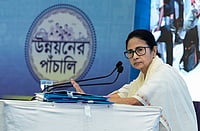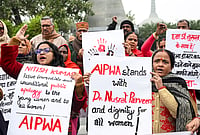Our country's situation is piquant. At a time when we need engineers to build infrastructure, graduates from the IITS are being lured abroad. At a time when the elite should create a robust public spirit because privatisation's taking place in an ocean of the destitute, the brainy and rich have seceded from their birthplace. We're a nation that needs to be built precisely at a moment in history when 'nation-building' has been declared passe.
Down and Out, Labouring Under Global Capitalism-a book about the unseen migrant labour force that heaves the global economy on its back-is an optimistic book. Its authors haven't produced a 'happening' book about the fashionable chiaroscuro of poverty. Instead, it's a matter-of-fact book. Its text is straightforward, its pictures are direct, its design neat and precise. It appears as a coffee table because it asks to be read. It insists that we read about the dignity of the widow who leaves her two-year-old in the care of her four-year-old and walks to a brick kiln miles away to slog there all day. It hopes that we might suffer with the busy three-year-old who races through the night, back and forth, carrying bricks to earn wages to feed his father. Hopes that we'll spare a thought that diamonds glitter with the breathless sweat of cutters who chip at the jewels in airless suffocating ateliers. It states simply, truthfully that at every point of economic consumption in India, hot calloused hands and grimy baby feet provide the crucial synapses. Liberalisation and globalisation need not be bad words. But without investment in social infrastructure and systematic efforts to include the poor in the ambit of economic reforms, the words have simply come to mean an amoral and shallow Get Rich Quick mentality where all culture's kitsch, all wealth reserved for the lucky few.
Breman, professor of sociology in Amsterdam, has studied workers in the Gujarat area for decades and in an intimate and moving prologue writes about the tribal Dublas of the west coast and the similarity between their lives and the barge people of the Netherlands during the World War II, a community to which his parents belonged. Although conditions for the barge people have improved dramatically over the years, the Dublas' lot has improved only marginally since he first met them 40 years ago.
Arvind Das' text moves through the different stages of the life of a landless worker: the village, where migrations have led to communities being depleted of able-bodied men. The patterns of movement of the poor, the often precise knowledge of markets and addresses of 'jobbers' or 'mukadams'. The rough shelters of the rootless. And finally the industries in which those who only have labour to sell must survive: the silk mills, diamond ateliers, sugarcane fields and brick kilns. Driven off land which can no longer absorb them and rejected by the capital-intensive 'formal' sector the migrant worker ends up sick, sleepless and brutalised.
The only point of disagreement one may have is that the terrible suffering of the footloose workforce is laid squarely at the door of the globalising economy without specific instances proving how conditions may have significantly worsened after the dismantling of the socialist state. Das says labour's been made more vulnerable in relation to capital and the globalising economy has 'informalised' and 'localised' labour because of the cruel demands of global capital, yet the Indian state's neglect of the labouring poor surely has a longer history?
Down and Out is a powerful statement and Agarwal's photographs complement excellently text that pours forth as much from the heart as the head. In times of hectically 'global' illusions, this book is aimed at the privileged, begging them to remember that horrifying poverty and inequality still spices their food and airconditions their air.


























